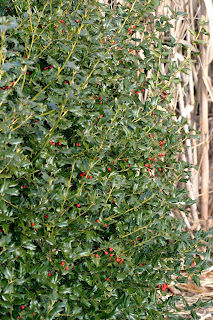Below are some images of the many wonderfully ornamental plants that really show off at Powell Gardens in the winter. I feel like a broken record pushing the beauty of winter and its ornamental plants -- it is something I always consider while acquiring plants through the year. My how these plants can really shine now, especially when viewed from indoors. I do recommend a new book on winter gardening: The Garden in Winter by Suzy Bales. Suzy (from Long Island, New York) has spoken at Powell Gardens and I had the pleasure to show off our grounds to her pre-Easter freeze in 2007.

American Holly (Ilex opaca) is perhaps the classic winter garden plant and such a symbol of holiday decor. As with all hollies, only female plants produce fruit and most need pollinators nearby (some hybrids produce fruit without pollination). Plant this long-lived, slow but beautiful tree for future generations to enjoy! It is hard to find and generally available only by mailorder in Kansas City. There are magnificent small trees in the 30-40 foot range in the older parts of Kansas City and its older suburbs. This evergreen is native to southeast Missouri and part of Missouri's Grow Native! program.

Greenleaf Holly (Ilex x attenuata 'Greenleaf') is a hybrid between the American Holly and Dahoon (Ilex cassine). Because this holly has hybrid vigor and grows very fast and is easy to propagate it is readily available at nurseries. It has smaller fruits that the birds really relish but is much less hardy then American Holly. It grows more int the 20 - 30 foot range in our area. Be sure to plant it in a sheltered place when outside Kansas City's "heat island." Yes, the core of the city is usually 5 degrees warmer than the surroundings - year round! This plant has completely died back here (2001) but recovered well.

Blue Princess Holly (Ilex x meservae 'Blue Princess') is a beautiful hybrid shrub holly that is very hardy. It is a cross between a cold hardy holly (Ilex rugosa) from Hokkaido(north island), Japan and the beautiful yet non-hardy English Holly (Ilex aquifolium). There are several cultivars in this group but Blue Princess has the best, glossy leaves with a hint of blue. We also have 'Blue Maid' in this group with 'Blue Stallion' as pollinator. This holly does not like extreme heat and the big swings of temperatures we can have here. Our plants killed to the ground one year (2001)but have completely recovered. I found it odd they died back when Southern Magnolias growing above them were uninjured! They are against the north wall of the Visitor Center where they stay cooler and shaded during the hot summer. This hybrid holly is readily available in nurseries and even big box retailers.

China Girl Holly is another hybrid holly using the hardy holly (Ilex rugosa) but it is crossed with the Chinese Holly (Ilex cornuta). This hybrid is much more apple green in leaf and stem as well as inheriting heat-tolerance from the China Holly. We grow these shrubs on the south side of the Visitor Center where it gets very hot in summer. The pollinator is aptly named 'China Boy.'

Acrocona Norway Spruce (Picea abies 'Acrocona') is a personal favorite of "dwarf" conifers. The abundant cones are very ornamental in winter (they are bright magenta in spring when emerging as female flowers!). This pine grows slowly to be at least 8 feet tall and wider than tall.

The flat sprays of golden foliage of this Rosenkranz Arborvitae (Thuja occidentalis 'Rosenkranz') create some warm color in this season. The green backdrop (a weeping common juniper) helps set the color off. This beautiful dwarf conifer is not readily available in local nurseries.

The blue needles of the St. Mary's Broom Blue Spruce (Picea pungens 'St. Mary's Broom') are so luxurious in winter. This true dwarf conifer is a favorite of Marvin Snyder of Overland Park, past President of the American Conifer Society and inspiration for our dwarf conifer garden at the north end of the Visitor Center. I like its contrast with the orangish Angelina (fore and background) and reddish Wehenstephaner Gold sedums which are neighboring low groundcovers.

Vintage Gold False Cypress (Chamaecyparis pisifera 'Vintage Gold') is a beacon of gold in the Fountain Garden. It is probably our most yellow of winter evergreens and has a very beautiful texture to the needles and sprays of young foliage.

Little Bluestem (Schizachyrium scoparium) though not evergreen is also at its showiest now when the dried, weathered stems and silky seed heads sparkle when back lit on these low sun angle days. This native prairie grass is a tough perennial that requires full sun and average soil. No extra water is ever required once it is established!


























































